
User Guide
SBV5120 Series
VoIP Cable Modem

User Guide
SBV5120 Series
VoIP Cable Modem

WARNING: TO PREVENT FIRE OR SHOCK HAZARD, DO NOT EXPOSE THIS PRODUCT TO RAIN OR
MOISTURE. THE UNIT MUST NOT BE EXPOSED TO DRIPPING OR SPLASHING. DO NOT PLACE OBJECTS
FILLED WITH LIQUIDS, SUCH AS VASES, ON THE UNIT.
CAUTION: THIS PRODUCT WAS QUALIFIED UNDER TEST CONDITIONS THAT INCLUDED THE USE OF
THE SUPPLIED CABLES BETWEEN SYSTEMS COMPONENTS. TO ENSURE REGULATORY AND SAFETY
COMPLIANCE, USE ONLY THE PROVIDED POWER AND INTERFACE CABLES AND INSTALL THEM PROPERLY.
CAUTION: DIFFERENT TYPES OF CORD SETS MAY BE USED FOR CONNECTIONS TO THE MAIN SUPPLY
CIRCUIT. USE ONLY A MAIN LINE CORD THAT COMPLIES WITH ALL APPLICABLE PRODUCT SAFETY
REQUIREMENTS OF THE COUNTRY OF USE.
CAUTION: INSTALLATION OF THIS PRODUCT MUST BE IN ACCORDANCE WITH NATIONAL WIRING
CODES AND CONFORM TO LOCAL REGULATIONS.
CAUTION: DO NOT OPEN THE UNIT. DO NOT PERFORM ANY SERVICING OTHER THAN THAT CONTAINED
IN THE INSTALLATION AND TROUBLESHOOTING INSTRUCTIONS. REFER ALL SERVICING TO QUALIFIED
SERVICE PERSONNEL.
CAUTION: CHANGES AND MODIFICATIONS NOT EXPRESSLY APPROVED BY MOTOROLA FOR
COMPLIANCE COULD VOID USER???S AUTHORITY TO OPERATE THE EQUIPMENT.
When using this device, basic safety precautions should always be followed to reduce the risk of fire, electric shock and injury to persons, including the following:
???Read all of the instructions listed here and/or in the user manual before you operate this equipment. Give particular attention to all safety precautions. Retain the instructions for future reference.
???This device must be installed and used in strict accordance with manufacturer???s instructions as described in the user documentation that comes with the product.
???Comply with all warning and caution statements in the instructions. Observe all warning and caution symbols that are affixed to this equipment.
???Do not overload outlets or extension cords, as this can result in a risk of fire or electric shock. Overloaded AC outlets, extension cords, frayed power cords, damaged or cracked wire insulation, and broken plugs are dangerous. They may result in a shock or fire hazard.
???Route power supply cords so that they are not likely to be walked on or pinched by items placed upon or against them. Pay particular attention to cords where they are attached to plugs and convenience receptacles, and examine the point where they exit from the product.
???Place this equipment in a location that is close enough to an electrical outlet to accommodate the length of the power cord.
???Place unit to allow for easy access when disconnecting the power cord of the device from the AC wall outlet.
???Do not connect the plug into an extension cord, receptacle, other outlet unless the plug can be fully inserted with no part of the blades exposed.
???Place this equipment on a stable surface.
???Postpone cable modem installation until there is no risk of thunderstorm or lightning activity in the area.
???Avoid using this product during an electrical storm. There may be a risk of electric shock from lightning. For added protection for this product during a lightning storm, or when it is left unattended and unused for long

periods of time, unplug it from the wall outlet, and disconnect the cable system. This will prevent damage to the product due to lightning and power surges.
???It is recommended that the customer install an AC surge protector in the AC outlet to which this device is connected. This is to avoid damaging the equipment by local lightning strikes and other electrical surges.
???Do not cover the device, or block the airflow to the device with any other objects. Keep the device away from excessive heat and humidity and keep the device free from vibration and dust.
???Wipe the unit with a clean, dry cloth. Never use cleaning fluid or similar chemicals. Do not spray cleaners directly on the unit or use forced air to remove dust.
???Avoid damaging the cable modem with static by touching the coaxial cable when it is attached to the earth grounded coaxial cable TV wall outlet.
???Always first touch the coaxial cable connector on the cable modem when disconnecting or
???Operate this product only from the type of power source indicated on the product???s marking label. If you are not sure of the type of power supplied to your home, consult your dealer or local power company.
???Upon completion of any service or repairs to this product, ask the service technician to perform safety checks to determine that the product is in safe operating condition.
Be sure that the outside cable system is grounded, so as to provide some protection against voltage surges and
FCC Compliance Class B Digital Device
This device complies with part 15 of the FCC Rules. Operation is subject to the following two conditions: (1) This device may not cause harmful interference, and (2) this device must accept any interference received, including interference that may cause undesired operation.
Note: This equipment has been tested and found to comply with the limits for a Class B digital device, pursuant to part 15 of the FCC Rules. These limits are designed to provide reasonable protection against harmful interference in a residential installation. This equipment generates, uses and can radiate radio frequency energy and, if not installed and used in accordance with the instructions, may cause harmful interference to radio communications. However, there is no guarantee that interference will not occur in a particular installation. If this equipment does cause harmful interference to radio or television reception, which can be determined by turning the equipment off and on, the user is encouraged to try to correct the interference by one or more of the following measures:
???Reorient or relocate the receiving antenna.
???Increase the separation between the equipment and receiver.
???Connect the equipment into an outlet on a circuit different from that to which the receiver is connected.
???Consult the dealer or an experienced radio/TV technician for help.

Canada - Industry Canada (IC)
This Class B digital device complies with Canadian
Cet appareil num??rique de la classe B est conforme ?? la norme
Regulatory, Safety, Software License, and Warranty Information Card
This product is provided with a separate Regulatory, Safety, Software License, and Warranty Information card. If one is not provided with this product, please ask your service provider or
???THIS PRODUCT IS IN COMPLIANCE WITH ONE OR MORE OF THE STANDARDS LISTED ON THE
REGULATORY, SAFETY, SOFTWARE LICENSE, AND WARRANTY INFORMATION CARD. NOT ALL
STANDARDS APPLY TO ALL MODELS.
???NO WARRANTIES OF ANY KIND ARE PROVIDED BY MOTOROLA WITH RESPECT TO THIS PRODUCT,
EXCEPT AS STATED ON THE REGULATORY, SAFETY, SOFTWARE LICENSE, AND WARRANTY
INFORMATION CARD. MOTOROLA???S WARRANTIES DO NOT APPLY TO PRODUCT THAT HAS BEEN
REFURBISHED OR REISSUED BY YOUR SERVICE PROVIDER.
Copyright ?? 2004 by Motorola, Inc.
All rights reserved. No part of this publication may be reproduced in any form or by any means or used to make any derivative work (such as translation, transformation or adaptation) without written permission from Motorola, Inc.
Motorola reserves the right to revise this publication and to make changes in content from time to time without obligation on the part of Motorola to provide notification of such revision or change. Motorola provides this guide without warranty of any kind, either implied or expressed, including, but not limited to, the implied warranties of merchantability and fitness for a particular purpose. Motorola may make improvements or changes in the product(s) described in this manual at any time.
MOTOROLA, Intelligence Everywhere, and the Stylized M Logo are registered in the US Patent & Trademark Office. Microsoft, Windows, Windows Me, and Windows NT are registered trademarks and Windows XP is a trademark of Microsoft Corporation. Microsoft Windows screen shots are used by permission of Microsoft Corporation. DOCSIS is a registered trademark of CableLabs. Linux is a registered trademark of Linus Torvalds. Solaris, Java, and all

Contents
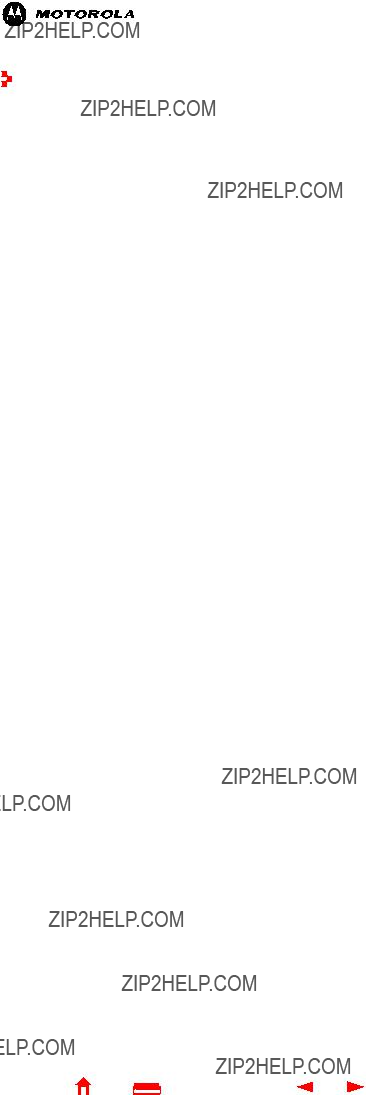
Introduction
Congratulations on your new Motorola?? SURFboard?? Voice over Internet Protocol (VoIP) cable modem! It provides
You can use your
???A single computer equipped with a Universal Serial Bus (USB) port directly to the USB port on the SURFboard VoIP cable modem
???A single computer equipped with an Ethernet adapter directly to the Ethernet port on the SURFboard VoIP cable modem
???Two computers, one to the USB port and one to the Ethernet port
???Up to 31 computers to a single SURFboard VoIP cable modem using an Ethernet hub, as shown in ???Cabling for Multiple Users??? on page 32
You can connect up to two standard telephone lines using your SURFboard VoIP cable modem, supporting:
???
???
Standard features such as Caller ID, Call Waiting, and Call Forwarding
Software upgrades over the network to provide new or improved services
Easier!
Unlike
Faster!
Your VoIP cable modem is up to 100 times faster than a
Better!
Your VoIP cable modem is made by the company with over 50 years of cable TV expertise.

Top and Front Panel
For added security, when using coaxial cable for upstream communication, you can press the Standby button (1) to suspend your Internet connection. No data is transmitted or received from the Internet when the Standby light is on. All other
The model number on your VoIP cable modem may be different than in the illustrations and screen images in this guide.
SBV5120
SURFboard??
Cable Modem
1
2
3
4
5
6
7
8
9
The lights provide information about power, communications, and errors:
During normal operation, the Power, Receive, Send, and Online lights are on and the Link light flashes when the VoIP cable modem is transferring data.
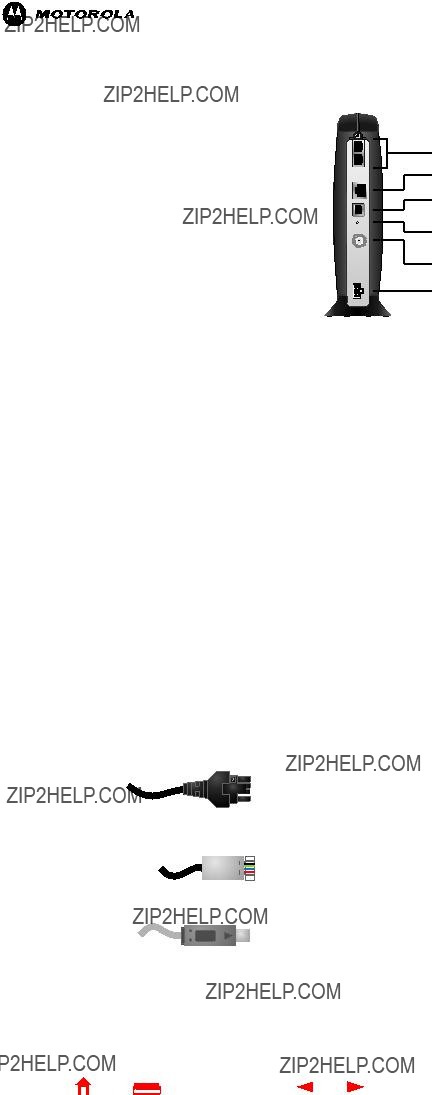
Rear Panel
The rear panel provides cabling connectors and the power receptacle.
3ETHERNET The Ethernet port provides a connection to Ethernet equipped computers using a cable
terminated with an
Before You Begin
Before you begin the installation, check that you received the following items with your SURFboard VoIP cable modem:

You will need
Caution
To comply with all national safety regulations, do not route the USB,
Ethernet, or telephone cables outside of the building.
Precautions
Postpone VoIP cable modem installation until there is no risk of thunderstorm or lightning activity in the area.
To avoid damaging the VoIP cable modem with static electricity:
???Always first connect the coaxial cable to the grounded cable TV wall outlet.
???Before you connect or disconnect the USB or Ethernet cable from your VoIP cable modem or PC, always touch the coaxial cable connector on the VoIP cable modem to release any static charges.
To avoid damaging your VoIP cable modem or PC with static electricity:
Before you connect or disconnect the USB or Ethernet cable, touch the coaxial cable connector on the VoIP cable modem.
 ETHERNET
ETHERNET
 USB
USB
 CABLE
CABLE
+12VDC
Always make the wall connection first.
To prevent overheating the VoIP cable modem, do not block the ventilation holes on its sides.
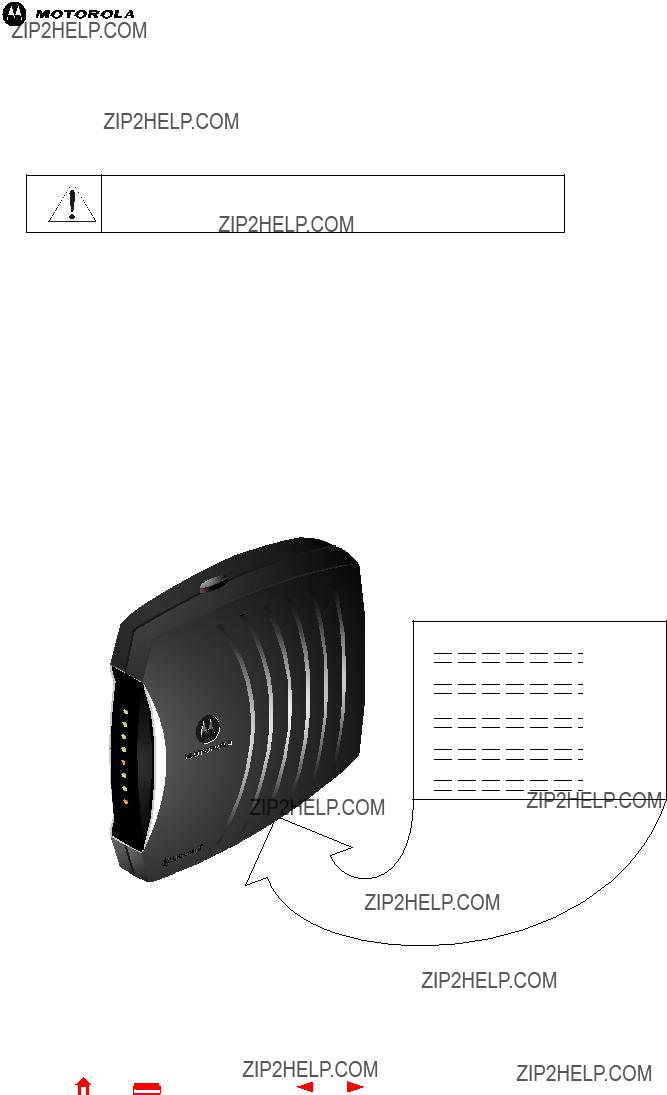
Do not open the VoIP cable modem. Refer all service to your cable service provider.
Wipe the VoIP cable modem with a clean, dry cloth. Never use cleaning fluid or similar chemicals. Do not spray cleaners directly on the unit or use forced air to remove dust.
Caution
Contact your cable service provider before connecting your VoIP cable modem to your existing telephone wiring. Do not connect the telephone wire to a traditional telephone (PSTN) service.
Signing Up for Service
You must sign up with a cable service provider to access the Internet and other online services.
To activate your service, call your local cable service provider.
To receive data service, you need to provide the MAC address printed on the bar code label marked CM HFC MAC ID on the bottom of the cable modem. You can record it here:
00 : ______ : ______ : ______ : ______ : ______
To receive telephone service, you need to provide the MAC address printed on the bar code label marked MTA MAC ID on the bottom of the cable modem. You can record it here:
00 : ______ : ______ : ______ : ______ : ______
P/N:
CUSTOMER S/N: BCDFGHJKLMNP
You should ask your cable service provider the following questions:
???
???
Do you have any special system requirements?
When can I begin to use my VoIP cable modem?

???
???
Are there any files I need to download after I am connected?
Do I need a user name or password to access the Internet or use
Computer System Requirements
You can use any Web browser, such as Microsoft?? Internet Explorer or Netscape Navigator??, with your SURFboard VoIP cable modem.
For Microsoft Windows computers, the Installation Assistant application automatically checks your system configuration. You can start the Installation Assistant from the Main Menu on the SURFboard VoIP Cable Modem
Your SURFboard VoIP cable modem is compatible with Microsoft Windows??, Macintosh??, and UNIX?? computers.
Ethernet Card
You can use the Ethernet connection with any Windows, Macintosh, or UNIX computer equipped with a
Windows?? 95, UNIX, or Macintosh computers must use the Ethernet connection.
If you use an Ethernet card, it must be installed in your computer before you install the VoIP cable modem. If it is not installed, follow the installation instructions provided with your Ethernet card.
USB Connection
You can use the USB connection with any PC running Windows?? 98, Windows?? 2000, Windows Me??, or Windows XP??? that has a USB interface. The USB connection requires special USB driver software that is supplied on the SURFboard VoIP Cable Modem
You can upgrade your USB drivers from our Downloads page http://broadband.motorola.com/noflash/ usb_drivers.asp.

Installation and Configuration Overview
To install and configure your VoIP cable modem for a single PC running Microsoft Windows, we recommend using the Installation Assistant. You can start the Installation Assistant from the Main Menu on the SURFboard VoIP Cable Modem
Otherwise, to install and configure your VoIP cable modem:
1Install the cables as described for your situation:
??????Cabling and Startup for a Single User??? on page 7
??????Cabling for Multiple Users??? on page 32
2If you are using the USB port only, go to ???Setting Up a USB Driver??? on page 9. Ethernet users can skip this step.
3Configure TCP/IP and verify the IP address for your computer as described for your situation:
??????Configuring TCP/IP??? on page 19
???Refer to your Macintosh or UNIX user manual for information regarding TCP/IP and IP Address configuration.
Cabling and Startup for a Single User
Allow some time (5 to 30 minutes) to power up the first time because the SURFboard VoIP cable modem must find and lock on the appropriate channels for communications.
Always connect coaxial cable to the wall outlet first.
 ETHERNET
ETHERNET
 USB
USB
 CABLE
CABLE
+12VDC
To cable outlet (step 2)
To electrical outlet or UPS (step 5)
SURFboard VoIP cable modem
1Be sure your computer is on and the VoIP cable modem is unplugged.
2Connect one end of the coaxial cable to the cable outlet or splitter. Connect the other end of the coaxial cable to the CABLE connector on the VoIP cable modem.
3Insert the SURFboard VoIP Cable Modem
4Connect one end of the telephone wire to the
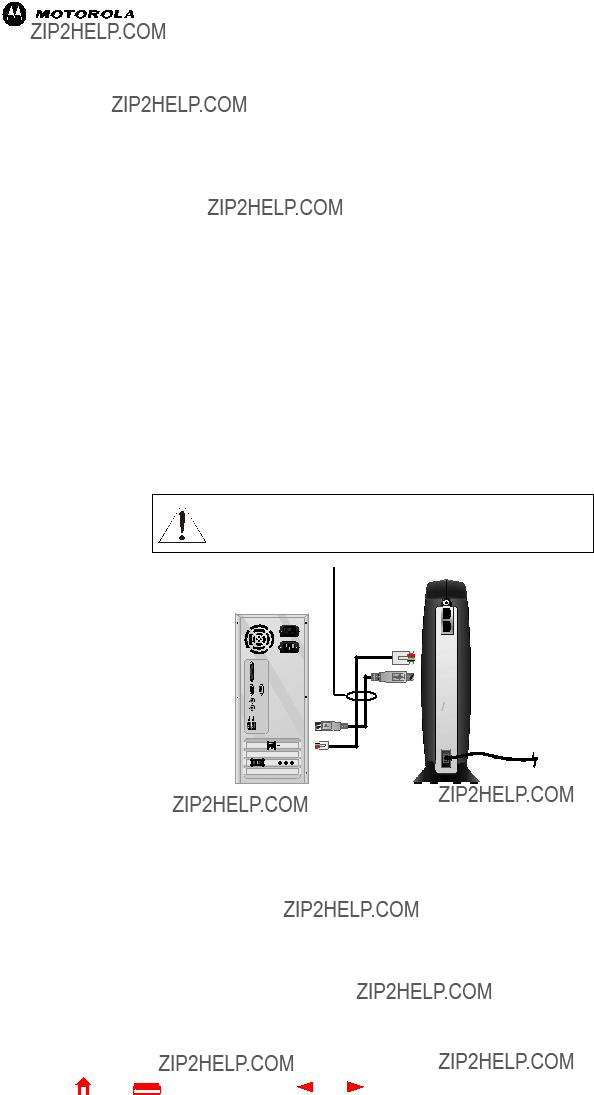
5Plug the power cord into the +12VDC connector on the VoIP cable modem and the electrical outlet. For an Uninterruptible Power Supply (UPS), plug the cord into the +12VDC connector on the VoIP cable modem and the UPS and plug the UPS into the electrical outlet.
For a power adapter, plug the adapter into the POWER connector on the VoIP cable modem and the electrical outlet. For a UPS, plug the cord into the POWER connector on the VoIP cable modem and the UPS and plug the UPS into the electrical outlet. This turns on the SURFboard VoIP cable modem. You do not need to unplug it when not in use.
6Check that the lights on the VoIP cable modem front cycle through this sequence:
???Power flashes during the
???Receive flashes while scanning for the receive (downstream) channel and changes to solid green when it is connected.
???Send flashes while scanning for the send (upstream) channel and changes to solid green when it is connected. If you use the internal
???Online flashes while the VoIP cable modem downloads configuration data and changes to solid green when the download is complete.
7Connect your computer to the VoIP cable modem using USB or Ethernet:
Caution
Do not connect both the Ethernet and USB cables to the same computer. Connect to either Ethernet or
USB


 CABLE USB ETHERNET
CABLE USB ETHERNET
 +12VDC
+12VDC 
SURFboard VoIP cable modem
USB: Be sure the SURFboard VoIP Cable Modem
Ethernet: Connect the provided
8Perform the procedures for ???Configuring TCP/IP??? on page 19.
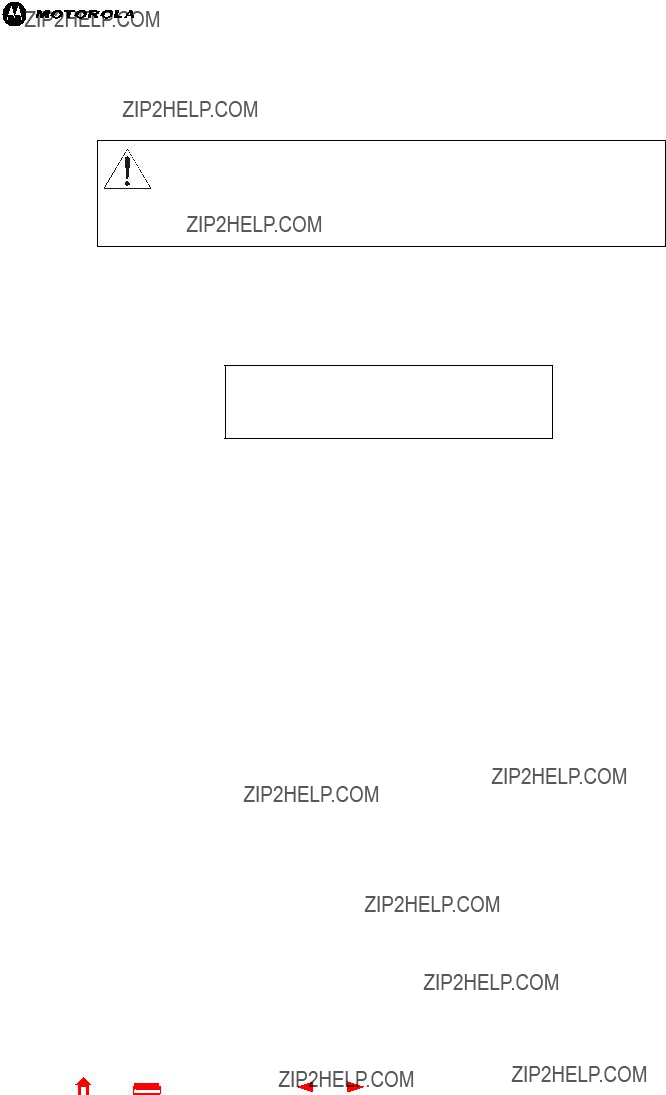
9To connect the telephone line, plug a phone wire into the Tel 1 connector. You can also connect a second telephone line to the Tel 2 connector.
Caution
Contact your cable service provider before connecting your VoIP cable modem to your existing telephone wiring. Do not connect the telephone wire to a traditional telephone (PSTN) service.
Be sure the phone connectors are neither connected together nor connected to wall jacks on the same network.
Setting Up a USB Driver
The following subsections describe setting up a USB driver. Perform the appropriate procedure for your Windows version:
Be sure the SURFboard VoIP Cable Modem
???
???
???
???
When you finish setting up the USB driver, you can continue with ???Configuring TCP/IP??? on page 19.
The SURFboard VoIP cable modem USB driver does not support Macintosh or UNIX computers. For those systems connect through Ethernet only.
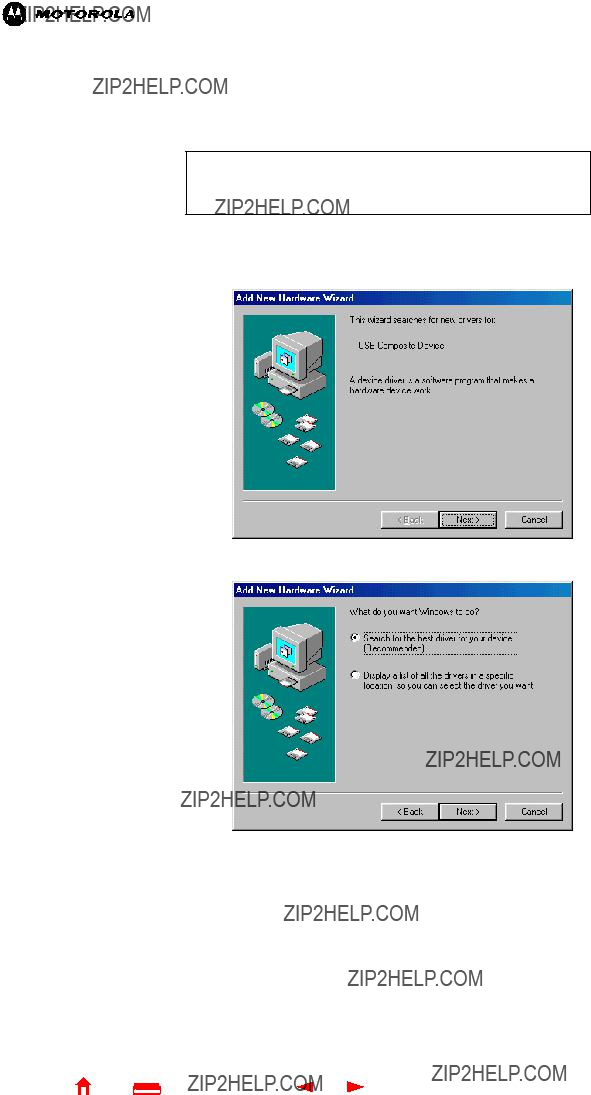
Setting Up a USB Driver in Windows 98
Be sure the SURFboard VoIP Cable Modem
Although your SURFboard VoIP cable modem model number may be different than in the images in this guide, the procedure is the same.
1Connect the VoIP cable modem to your computer with a USB cable. For further instructions, see ???Cabling and Startup for a Single User??? on page 7. A few seconds after you complete the USB connection, the Add New Hardware Wizard window is displayed:
2Click Next.
3Be sure ???Search for the best driver for your device??? is selected and click Next.

4Be sure
5Click Next.
The message ???Please wait while Windows searches for a new driver for this device??? is displayed:
6If your computer successfully locates the driver, skip to step 8.
If your computer does not locate the driver, the previous window is displayed again. Select Specify a location and type the location of your
To load the driver successfully, you may need to click Browse to manually select the driver file from the
7Click Next.

8Select The updated driver... and click Next.
If this window is not displayed, verify that the SURFboard VoIP Cable Modem
9After the window is displayed, click Next.
If a window with the message Copying Files... displays and asks for your
If an Insert Disk window similar to the one below is displayed, Windows 98 system files are needed to complete the installation. To install the files, insert your Windows 98
Although your SURFboard VoIP cable modem model number may be different than in the images in this guide, the procedure is the same.

After all the necessary files are loaded, the window is displayed confirming a successful installation.
10 Click Finish. The following window is displayed:
11 Click Yes to restart your computer.
When you finish setting up the USB driver, you can continue with ???Configuring TCP/IP in Windows 95, 98, or Windows Me??? on page 20.
If you have difficulties setting up the USB driver, perform ???Removing the USB Driver from Windows 98 or Windows Me??? on page 34 and repeat this procedure. If that does not correct your problem, see the Regulatory, Safety, Software License, and Warranty Information card provided with your SURFboard VoIP cable modem for information about obtaining warranty service.
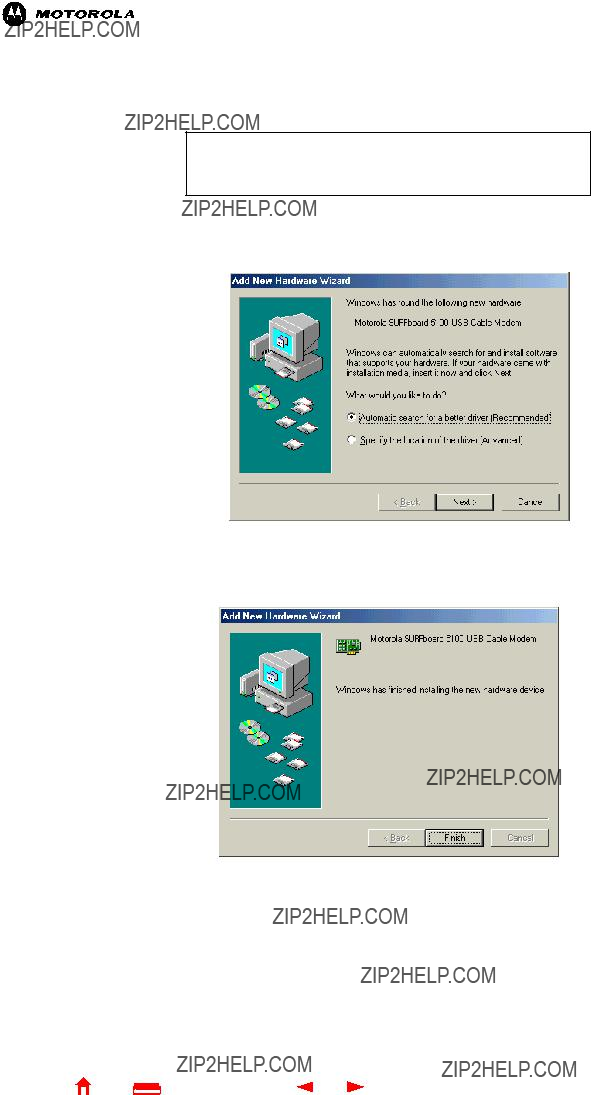
Setting Up a USB Driver in Windows Me
Be sure the SURFboard VoIP Cable Modem
Although your SURFboard VoIP cable modem model number may be different than in the images in this guide, the procedure is the same.
1Connect the VoIP cable modem to your computer with a USB cable. For further instructions, see ???Cabling and Startup for a Single User??? on page 7. A few seconds after you complete the USB connection, the Add New Hardware Wizard window is displayed:
2Click Next. Windows automatically searches for the correct USB drivers and installs them. If the installation is successful, the following window is displayed. Otherwise, be sure the SURFboard VoIP Cable Modem
3Click Finish to complete the installation.
When you finish setting up the USB driver, you can continue with ???Configuring TCP/IP in Windows 95, 98, or Windows Me??? on page 20.
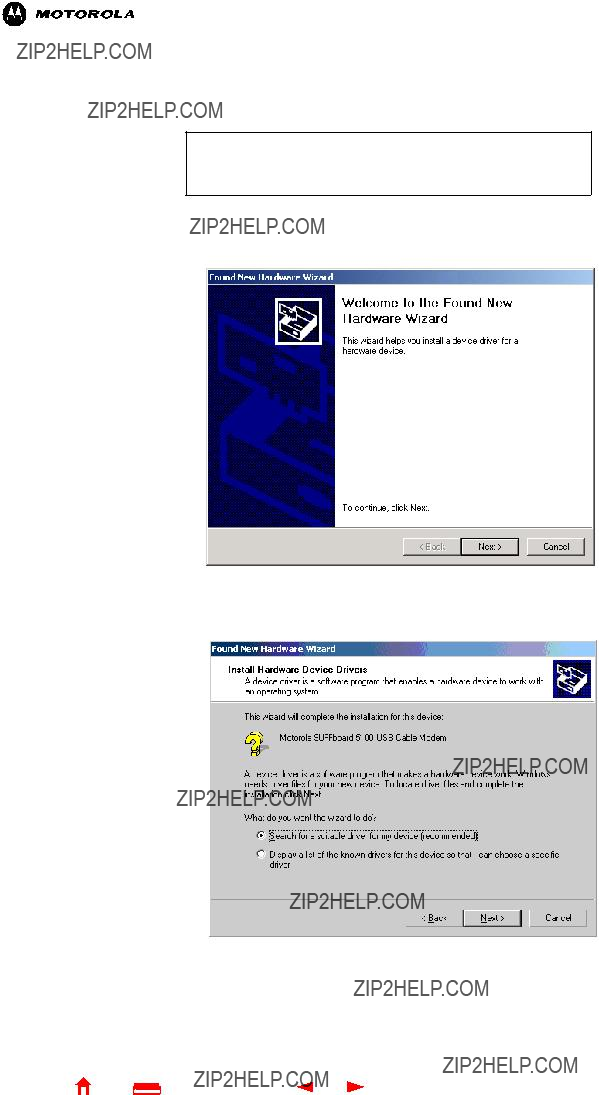
Setting Up a USB Driver in Windows 2000
Be sure the SURFboard VoIP Cable Modem
Although your SURFboard VoIP cable modem model number may be different than in the images in this guide, the procedure is the same.
1Connect the VoIP cable modem to your computer with a USB cable. For further instructions, see ???Cabling and Startup for a Single User??? on page 7. A few seconds after you complete the USB connection, the Found New Hardware Wizard window is displayed:
2Click Next.
3Be sure ???Search for a suitable driver for my device??? is selected.
4Click Next.

5Be sure
6Click Next.
7If the Insert Disk window is displayed, be sure the SURFboard VoIP Cable Modem
8On the Insert Disk window, click OK.
9If necessary, select your
10 Click Browse.
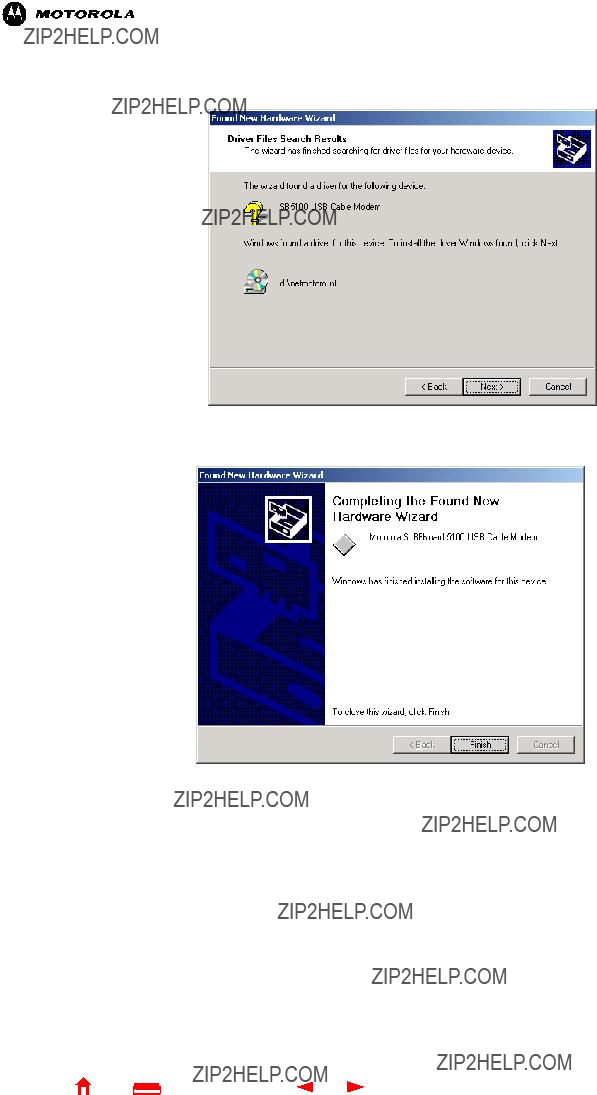
11Locate and
12 Click OK. The Found New Hardware Wizard window is displayed:
13 Click Finish to complete the installation.
When you finish setting up the USB driver, you can continue with ???Configuring TCP/IP in Windows 2000??? on page 22.
If you have any difficulties setting up the USB driver, perform ???Removing the USB Driver from Windows 2000??? on page 36 and repeat this procedure.

Setting Up a USB Driver in Windows XP
Be sure the SURFboard VoIP Cable Modem
Although your SURFboard VoIP cable modem model number may be different than in the images in this guide, the procedure is the same.
1Connect the VoIP cable modem to your computer with a USB cable. For further instructions, see ???Cabling and Startup for a Single User??? on page 7. A few seconds after you complete the USB connection, the Found New Hardware Wizard window is displayed:
2Be sure ???Install the software automatically??? is selected.
3Click Next. Windows automatically searches for the correct USB drivers and installs them.
4Click Finish to complete the installation. Otherwise, be sure the SURFboard VoIP Cable Modem

When you finish setting up the USB driver, you can continue with ???Configuring TCP/IP in Windows XP??? on page 26.
Although your SURFboard VoIP cable modem model number may be different than in the images in this guide, the procedure is the same.
Configuring TCP/IP
The SURFboard VoIP cable modem contains all required software. You do not need to configure the VoIP cable modem, but you must be sure that your computer is configured for TCP/IP (a protocol for communication between computers). Perform one of the following:
???
???
???
???
???Configuring TCP/IP in Windows 95, 98, or Windows Me??? on page 20
???Configuring TCP/IP in Windows 2000??? on page 22
???Configuring TCP/IP in Windows XP??? on page 26
Follow the instructions in your Macintosh or UNIX user manual
After configuring TCP/IP, perform one of the following to verify the IP address:
???
???
???
???Verifying the IP Address in Windows 95, Windows 98, or Windows Me??? on page 29
???Verifying the IP Address in Windows 2000 or Windows XP??? on page 30
Follow the instructions in your Macintosh or UNIX user manual
Your cable service provider may provide additional instructions to set up your computer.

Configuring TCP/IP in Windows 95, 98, or Windows Me
1On the Windows Desktop, click Start.
2Select Settings and then Control Panel from the
3
4Select the Configuration tab.
5Verify that TCP/IP is installed for the adapter that will be used to connect to the VoIP cable modem by looking for TCP/IP. If found, TCP/IP is installed. Skip to step 10. If TCP/IP is not installed for the adapter, continue with step 6.
6Select the adapter to be used for the SURFboard cable modem connection and then click Add. The Select Network Component Type window is displayed:

7Select the Protocol option and click Add. The Select Network Protocol window is displayed:
8Click Microsoft in the Manufacturers section and click TCP/IP in the Network Protocol section of Select Network Protocol window.
9Click OK.
10Click TCP/IP on the Network window. If there is more than one TCP/IP entry, choose the one for the Ethernet card or USB port connected to the VoIP cable modem.
11Click Properties. The TCP/IP Properties window is displayed:
12Click the IP Address tab.
13Click Obtain an IP address automatically.
14Click OK to accept the TCP/IP settings.
15Click OK to close the Network window.
16Click OK when prompted to restart your computer and click OK again.

When you complete TCP/IP configuration, go to ???Verifying the IP Address in Windows 95, Windows 98, or Windows Me??? on page 29.
Configuring TCP/IP in Windows 2000
1On the Windows Desktop, click Start.
2Select Settings and then Control Panel from the
3
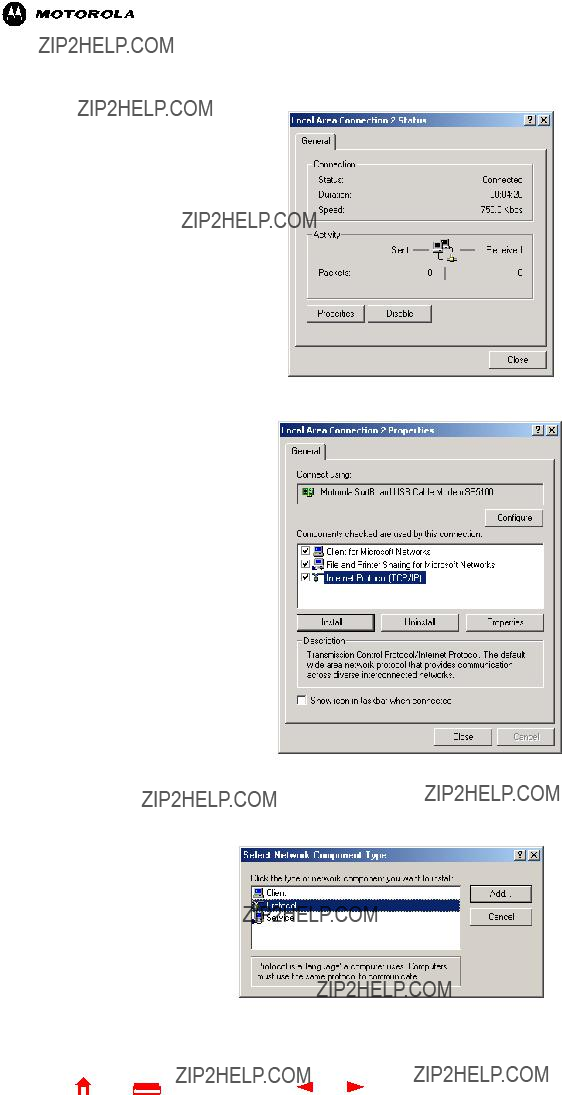
4
5Click Properties. The Local Area Connection Properties window is displayed:
6If Internet Protocol (TCP/IP) is in the list of components, TCP/IP is installed. You can skip to step 10.
If Internet Protocol (TCP/IP) is not in the list, click Install. The Select Network Component Type window is displayed: Continue with step 7.
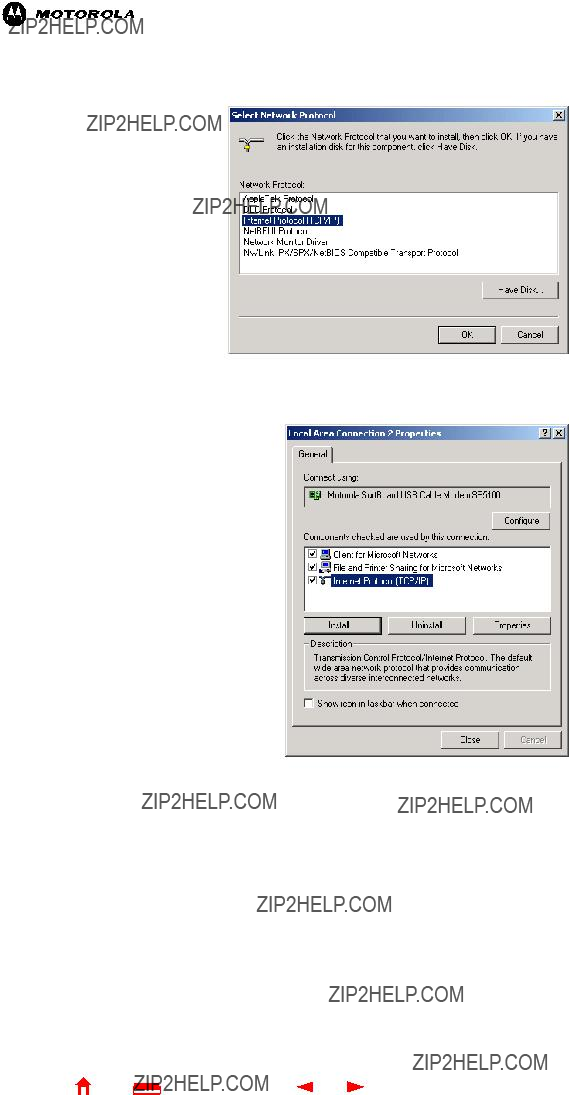
7Click Protocol on the Select Network Component Type window and click Add. The Select Network Protocol window is displayed:
8Click Internet Protocol (TCP/IP) in the Network Protocol section on the Select Network Protocol window.
9Click OK. The Local Area Connection number Properties window is
10On the Local Area Connection number Properties window, be sure the box next to Internet Protocol (TCP/IP) is checked.
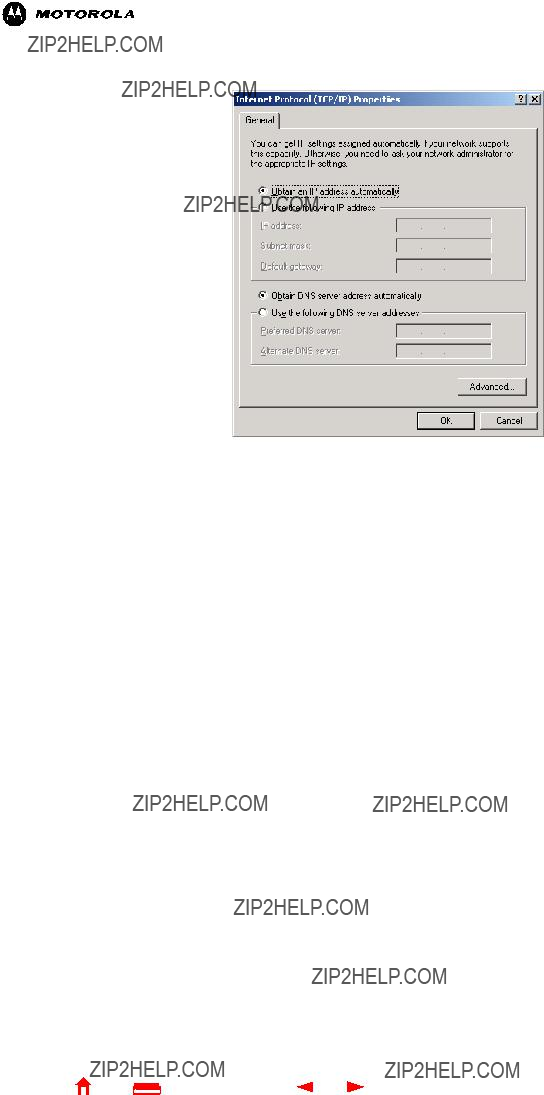
11 Click Properties. The Internet Protocol (TCP/IP) Properties window is displayed:
12Be sure Obtain IP address automatically and Obtain DNS server address automatically are selected. Click OK to accept the TCP/IP settings.
13Click OK to close the Local Area Connection number Properties window.
14Click OK when prompted to restart your computer and click OK again.
When you complete the TCP/IP configuration, go to ???Verifying the IP Address in Windows 2000 or Windows XP??? on page 30.
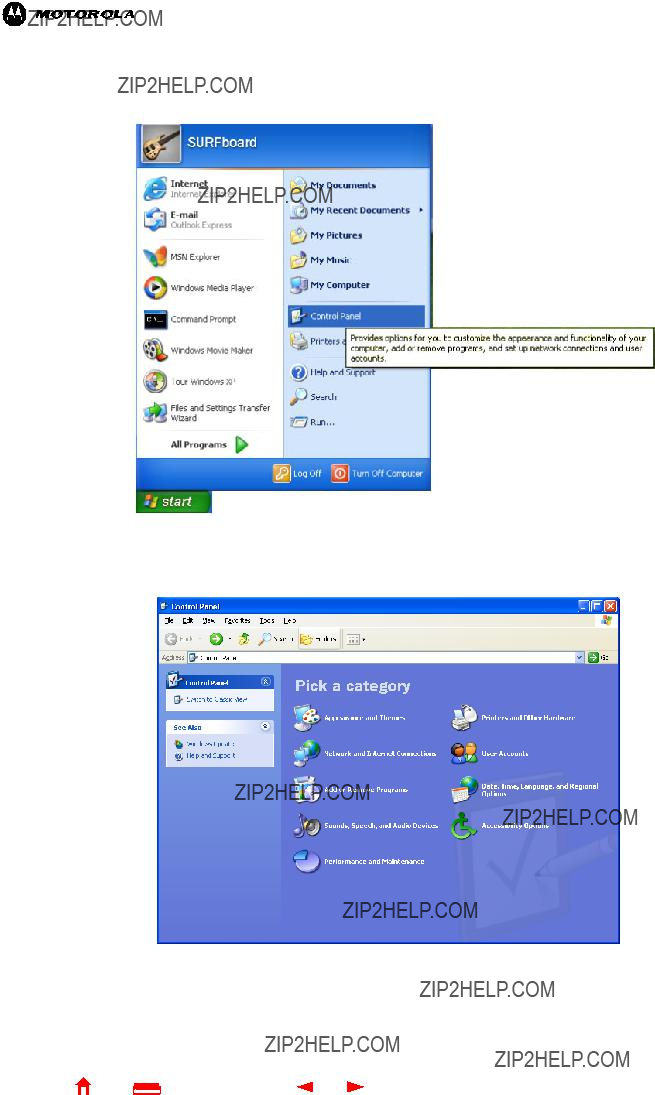
Configuring TCP/IP in Windows XP
1On the Windows desktop, click Start to display the Start window shown.
2Click Control Panel to display the Control Panel window. The display varies, depending on your Windows XP view options. If the display is a Category view as shown below, continue with step 3. Otherwise, skip to
step 5.

3Click Network and Internet Connections. The Network and Internet Connections window is displayed.
4On the Network and Internet Connections window, click Network Connections to display the LAN or
5If a classic view similar to below is displayed, click Network Connections to display the LAN or

6
7Select Properties from the
8On the Local Area Connection Properties window, be sure Internet Protocol (TCP/IP) is checked. If it is not checked, check it.

9Select Internet Protocol (TCP/IP) and click Properties to display the Internet Protocol (TCP/IP) Properties window.
10On the Internet Protocol (TCP/IP) Properties window, verify that the settings are correct, as shown.
11Click OK to close the TCP/IP Properties window.
12Click OK to close the Local Area Connection Properties window.
When you complete the TCP/IP configuration, go to ???Verifying the IP Address in Windows 2000 or Windows XP??? on page 30.
Verifying the IP Address
The following subsections describe verifying an IP Address. Perform the appropriate procedure for you Windows version:
??????Verifying the IP Address in Windows 95, Windows 98, or Windows Me??? on page 29
??????Verifying the IP Address in Windows 2000 or Windows XP??? on page 30
For a Macintosh or UNIX system, refer to your user guide.
Verifying the IP Address in Windows 95, Windows 98, or Windows Me
To check the IP address:
1On the Windows Desktop, click Start.
2Select Run. The Run window is displayed.

3Type winipcfg.exe and click OK. A window similar to the example is displayed:
The example values for Adapter Address, IP Address, Subnet Mask, and Default Gateway on your PC will be different than in the image above.
In Windows 98, if autoconfiguration is displayed before the IP Address, call your service provider.
4Select your adapter name ??? the Ethernet card or USB device.
5Click Renew.
6Click OK after the system displays an IP address.
If after performing this procedure your computer cannot access the Internet, call your cable service provider for help.
Verifying the IP Address in Windows 2000 or Windows XP
To check the IP address:
1On the Windows Desktop, click Start.
2Select Run. The Run window is displayed.
3Type cmd and click OK.
4Type ipconfig and press ENTER to display your IP configuration. A display, like below, indicates a normal configuration.

If an Autoconfiguration IP Address is displayed as in the window below, there is an incorrect connection between your PC and the VoIP cable modem or there are cable network problems.
Check:
???
???
Your cable connections
Whether you can see
After successfully verifying your cable connections and proper
Renewing Your IP Address
To renew your IP address:
1On the Windows Desktop, click Start.
2Select Run. The Run window is displayed.
3Type cmd and click OK.
4Type ipconfig /renew and press ENTER. If a valid IP address is displayed as shown, Internet access should be available.
5Type exit and press ENTER to return to Windows.
If after performing this procedure your computer cannot access the Internet, call your cable service provider for help.
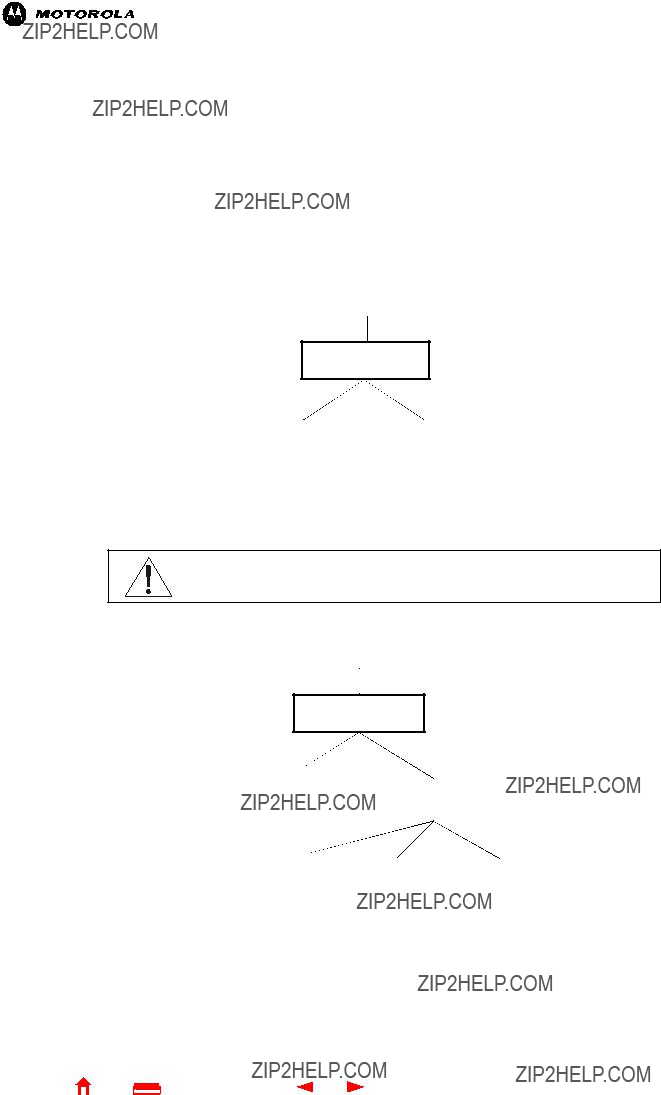
Cabling for Multiple Users
The SURFboard VoIP cable modem supports several multiple user configurations. Along with an optional hub or router, it can serve as an Internet gateway for up to 31 computers.
Not all service providers support multiple user service. For information about multiple user service, contact your cable service provider.
Ethernet and USB
You can connect the USB port on one computer and the Ethernet port on another computer directly to the VoIP cable modem, as shown.
Cable outlet Coaxial cable
SURFboard VoIP cable modem
Caution
Do not connect both the Ethernet and USB cables to the same computer.
You can connect a single computer to the USB port and from one to 31 remaining users to an Ethernet hub, as shown. You cannot connect more than one computer to the VoIP cable modem through the USB port.
Cable outlet
 Coaxial cable
Coaxial cable
SURFboard VoIP cable modem

Ethernet
You can connect up to 31 computers to an Ethernet hub connected to a SURFboard VoIP cable modem, as shown.
Cable outlet
Coaxial cable
SURFboard VoIP
cable modem
Ethernet cable
Ethernet hub or switch
Ethernet cable
Computer Computer Computer
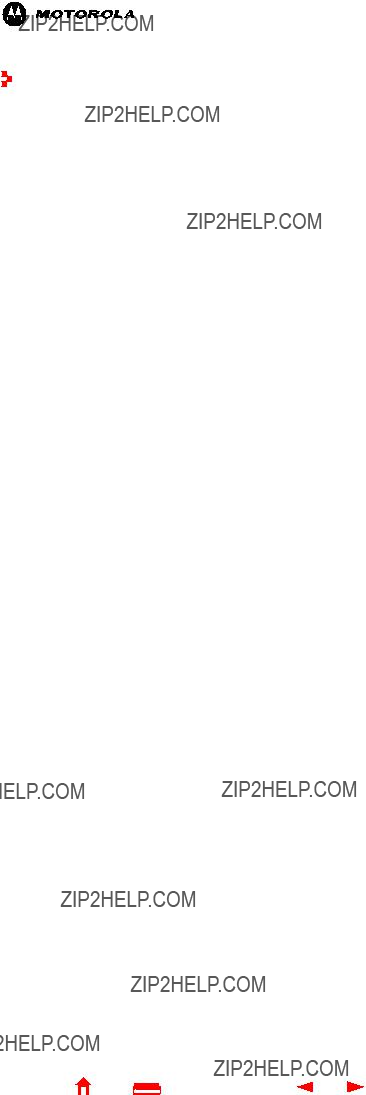
Troubleshooting
If the solutions listed here do not solve your problem, contact your cable service provider. Before calling your service provider, try unplugging and plugging in the cable modem power cord in the AC wall outlet to restart the cable modem. Restarting the cable modem may take 5 to 30 minutes.
Before calling your service provider, try pressing the reset button on the rear panel. Resetting the VoIP cable modem may take 5 to 30 minutes. Your service provider may ask for the status of the
???Check that the electrical outlet is working.
???If the Standby light is on, the Internet connection is off. Press the Standby button to reconnect to the Internet.
???If all lights are off except the Standby light, the VoIP cable modem is in Standby mode. Press the Standby button to reconnect your Internet service. The Standby button does not affect the Tel1/Tel2 LEDs.
???If you have cable TV, check that your TV is working and the picture is clear. If you cannot receive your regular TV channels, your data service will not function.
???Check the coaxial cable at the VoIP cable modem and wall outlet.
???Check the IP address. Follow the steps in ???Verifying the IP Address in Windows 95, Windows 98, or Windows Me??? on page 29 or ???Verifying the IP Address in Windows 2000 or Windows XP??? on page 30. Call your cable service provider if you need an IP address.
???Check that the USB or Ethernet cable is properly connected to the VoIP cable modem and your computer.
Problems related to unsuccessful Remove the USB driver. Follow the instructions in one of:
USB driver installation??? ???Removing the USB Driver from Windows 98 or Windows Me??? on page 34
??????Removing the USB Driver from Windows 2000??? on page 36
??????Removing the USB Driver from Windows XP??? on page 40

Note: For Tel 1 and 2, if the LED is not lit and the telephone line is properly connected, the line has not been setup for service by the telephone service provider. Contact your provider.
For more information about the lights, see ???Top and Front Panel??? on page 2.
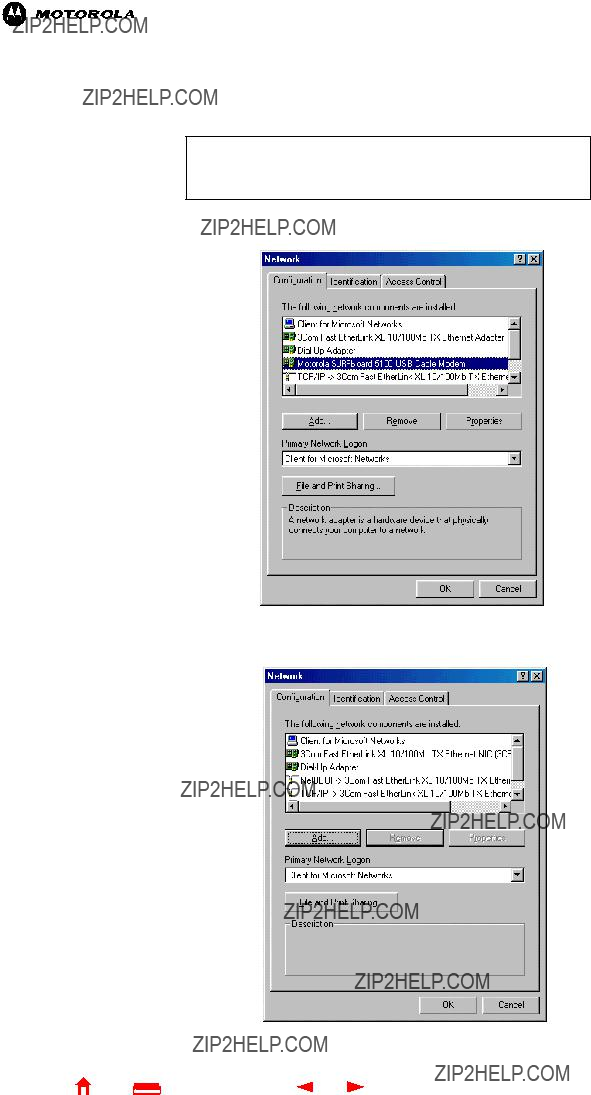
Removing the USB Driver
Removing the USB Driver from Windows 98 or Windows Me
Although your SURFboard VoIP cable modem model number may be different than in the images in this guide, the procedure is the same.
1On your Windows Desktop,
2Click the Motorola SURFboard USB Cable Modem and click Remove. The Network window no longer displays Motorola SURFboard USB Cable Modem in the list.

3Click OK. The System Settings Change window is displayed:
4Disconnect the USB cable from your computer or VoIP cable modem.
5Click Yes to restart your computer.
6Insert the SURFboard VoIP Cable Modem
7Press the Esc key on the keyboard to exit the
8Start Windows Explorer. Your Windows Explorer may appear slightly different than here.
9Select your

10
11 Click Remove Driver to remove the USB driver.
After you remove the USB driver,
???
???
If you continue to have problems, contact your cable service provider.
Removing the USB Driver from Windows 2000
Although your SURFboard VoIP cable modem model number may be different than in the images in this guide, the procedure is the same.
1On your Windows desktop, click Start.
2Click Settings.

3
4
5On the System Properties window, click the Hardware tab.

6Click Device Manager. The Device Manager window is displayed:
7On the Device Manager window,
8Click the Motorola SURFboard USB VoIP Cable Modem. The Uninstall icon is displayed on the window near the top.
9Click Uninstall.
10Close the Device Manager window.
11Close the Control Panel window.
12Insert the SURFboard VoIP Cable Modem
13Press the Esc key on the keyboard to exit the
14Start Windows Explorer.Your Windows Explorer may appear slightly different than here.
15Click My Computer.
16Click the Motorola CD icon (D: in the example).

17
18 Click Remove Driver.
After you remove the USB driver,

Removing the USB Driver from Windows XP
Although your SURFboard VoIP cable modem model number may be different than in the images in this guide, the procedure is the same.
1On the Windows desktop, click Start to display the Start window shown.
2Click Control Panel to display the Control Panel window. The display varies, depending on your Windows XP view options.
3If a Category view similar to above is displayed, click Performance and Maintenance. Otherwise, skip to step 5.
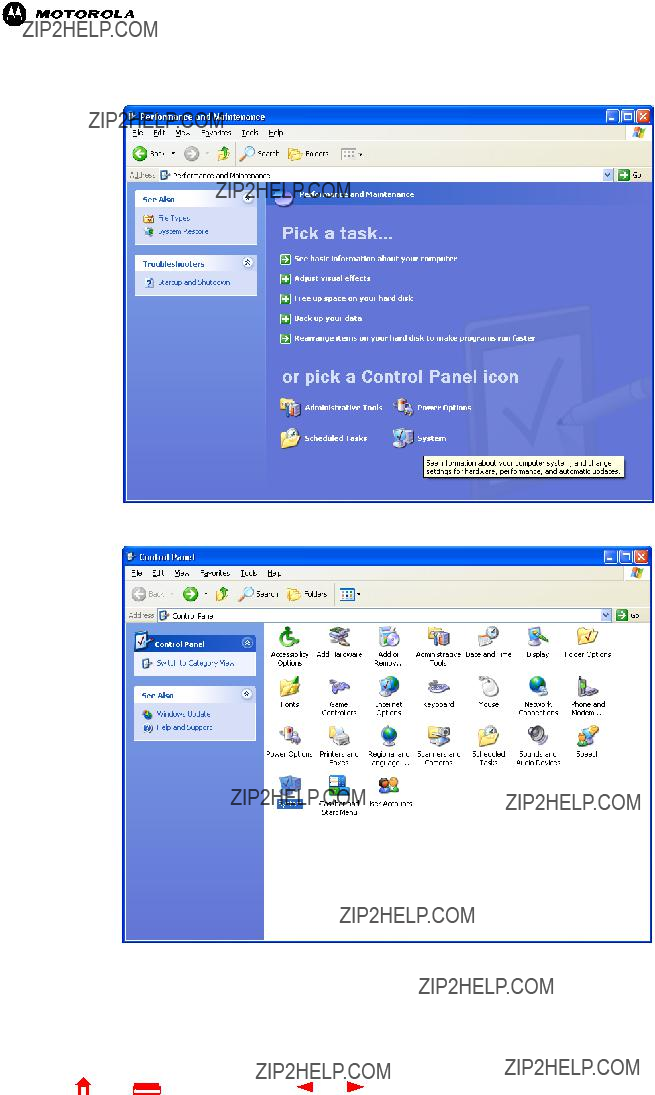
4On the Performance and Maintenance window, click System to display the System Properties window. Skip to step 6.
5If a classic view similar to below is displayed, click System to display the System Properties window.

6On the System Properties window, click the Hardware tab.
7Click Device Manager to display the Device Manager window.
8On the Device Manager window,
9Click the Motorola SURFboard USB Cable Modem. The Uninstall icon is displayed on the window near the top. Click Uninstall.
10Close the Device Manager window.
11Close the Control Panel window.
12Insert the SURFboard VoIP Cable Modem

13Press the Esc key on the keyboard to exit the
14Start Windows Explorer. Your Windows Explorer may appear slightly different than here.
15Click My Computer.
16Click the Motorola CD icon (D: in the image).
17
18 Click Remove Driver.
After you remove the USB driver,
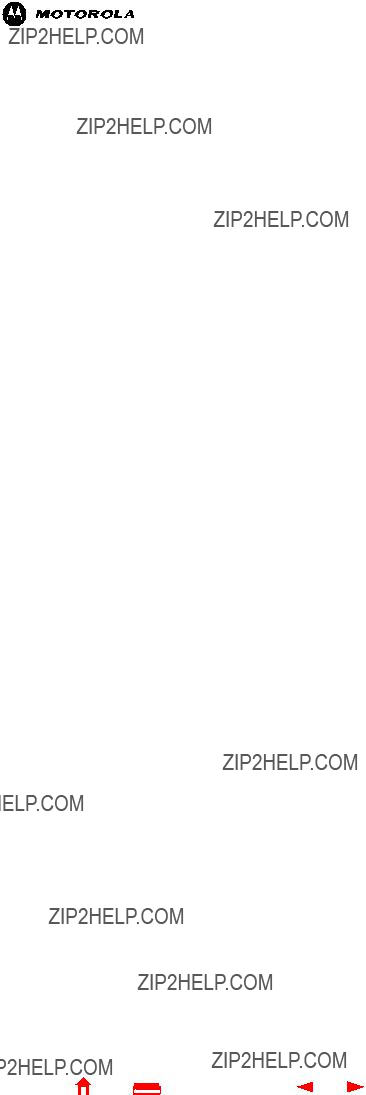
Contact Us
For information about customer service, technical support, or warranty claims, see the Regulatory, Safety, Software License, and Warranty Information card provided with your SURFboard VoIP cable modem.
In the United States and Canada, if you need assistance while working with the SURFboard VoIP cable modem and related equipment supplied by Motorola:
If you rent or lease your SURFboard VoIP cable modem
Contact your cable service provider.
If you own your SURFboard VoIP cable modem
Call
For answers to typical questions, see ???Frequently Asked Questions??? on page 47.
For information about Motorola consumer cable products, education, and support, visit www.motorola.com/ broadband/consumers.

Frequently Asked Questions
Here are answers to questions our customers frequently ask.
APacketCable??? is an evolving set of interface specifications for delivering advanced,
QIf I have a VoIP cable modem, can I still use my old 28.8 Kbps or 56 Kbps modem?
AYes! Although once you???ve experienced the speed of cable Internet access, you???ll never again want to wait for traditional
QI have more than one computer. Do I need more than one SURFboard VoIP cable modem?
ANo, not if your computers are connected on a network. The SURFboard VoIP cable modem supports current Internet connection sharing technologies to enable you to connect up to 31 computers to the Internet using a single VoIP cable modem.
ANo, but you will need to subscribe to cable Internet service. Some systems require that you subscribe to basic service before you can get Internet access and/or offer a discount when you use your own VoIP cable modem. Check with your local cable company for specific information.

A???Troubleshooting??? on page 34 provides tips to diagnose problems and simple solutions. If you continue to have problems, contact your cable service provider or Motorola as described in ???Contact Us??? on page 46.

Glossary
expansion slot An opening in a computer where a circuit board can be inserted to add new capabilities.
IP address An Internet Protocol address is an identifier for a computer or device on a TCP/IP network. Networks using the TCP/IP protocol route messages based on the destination IP address. Your cable service provider assigns your VoIP cable modem an IP address to provide a continuous Internet connection.
USB
VoIP
Universal Serial Bus is a computer interface for
Voice over Internet Protocol is a method to exchange voice, fax, and other information over the Internet. Voice and fax have traditionally been carried over traditional telephone lines using a dedicated circuit for each line. VoIP enables calls to travel as discrete data packets on shared lines.
Print Exit

Software License
SURFboard Cable Modems
Motorola, Inc., Broadband Communications Sector (???Motorola???) 101 Tournament Drive
Horsham, PA 19044
IMPORTANT: PLEASE READ THIS SOFTWARE LICENSE (???LICENSE???) CAREFULLY BEFORE YOU INSTALL,
DOWNLOAD OR USE ANY APPLICATION SOFTWARE, USB DRIVER SOFTWARE, FIRMWARE AND RELATED
DOCUMENTATION (???SOFTWARE???) PROVIDED WITH MOTOROLA???S CABLE DATA PRODUCT (THE ???CABLE DATA
PRODUCT???). BY USING THE CABLE DATA PRODUCT AND/OR INSTALLING, DOWNLOADING OR USING ANY OF
THE SOFTWARE, YOU INDICATE YOUR ACCEPTANCE OF EACH OF THE TERMS OF THIS LICENSE. UPON
ACCEPTANCE, THIS LICENSE WILL BE A LEGALLY BINDING AGREEMENT BETWEEN YOU AND MOTOROLA.
THE TERMS OF THIS LICENSE APPLY TO YOU AND TO ANY SUBSEQUENT USER OF THIS SOFTWARE.
IF YOU DO NOT AGREE TO ALL OF THE TERMS OF THIS LICENSE (I) DO NOT INSTALL OR USE THE SOFTWARE
AND (II) RETURN THE CABLE DATA PRODUCT AND THE SOFTWARE (COLLECTIVELY, ???PRODUCT???), INCLUDING
ALL COMPONENTS, DOCUMENTATION AND ANY OTHER MATERIALS PROVIDED WITH THE PRODUCT, TO
YOUR POINT OF PURCHASE OR SERVICE PROVIDER, AS THE CASE MAY BE, FOR A FULL REFUND. BY
INSTALLING OR USING THE SOFTWARE, YOU AGREE TO BE BOUND BY THE PROVISIONS OF THIS LICENSE
AGREEMENT.
The Software includes associated media, any printed materials, and any
The Software is never sold. Motorola licenses the Software to the original customer and to any subsequent licensee for personal use only on the terms of this License. Motorola and its 3rd party licensors retain the ownership of the Software.
You may:
USE the Software only in connection with the operation of the Product.
TRANSFER the Software (including all component parts and printed materials) permanently to another person, but only if the person agrees to accept all of the terms of this License. If you transfer the Software, you must at the same time transfer the Product and all copies of the Software (if applicable) to the same person or destroy any copies not transferred.
TERMINATE this License by destroying the original and all copies of the Software (if applicable) in whatever form. You may not:
(1) Loan, distribute, rent, lease, give, sublicense or otherwise transfer the Software, in whole or in part, to any other person, except as permitted under the TRANSFER paragraph above. (2) Copy or translate the User Guide included with the Software, other than for personal use. (3) Copy, alter, translate, decompile, disassemble or reverse engineer the Software, including but not limited to, modifying the Software to make it operate on
The Product is not designed or intended for use in
PARTY LICENSORS DISCLAIM ANY EXPRESS OR IMPLIED WARRANTY OF FITNESS FOR SUCH USES. YOU
REPRESENT AND WARRANT THAT YOU SHALL NOT USE THE PRODUCT FOR SUCH PURPOSES.
Title to this Software, including the ownership of all copyrights, mask work rights, patents, trademarks and all other intellectual property rights subsisting in the foregoing, and all adaptations to and modifications of the foregoing shall at all times remain with Motorola and its 3rd party licensors. Motorola retains all rights not expressly licensed under this License. The Software, including any images, graphics, photographs, animation, video, audio, music and text incorporated therein is owned by Motorola or its 3rd party licensors and is protected by United States copyright laws and international treaty provisions. Except as otherwise expressly provided in this License, the copying, reproduction, distribution or preparation of derivative works of the Software, any portion of the Product or the documentation is strictly prohibited by such laws and treaty provisions. Nothing in this License constitutes a waiver of Motorola???s rights under United States copyright law.
This License and your rights regarding any matter it addresses are governed by the laws of the Commonwealth of Pennsylvania, without reference to conflict of laws principles. THIS LICENSE SHALL TERMINATE AUTOMATICALLY if you fail to comply with the terms of this License.
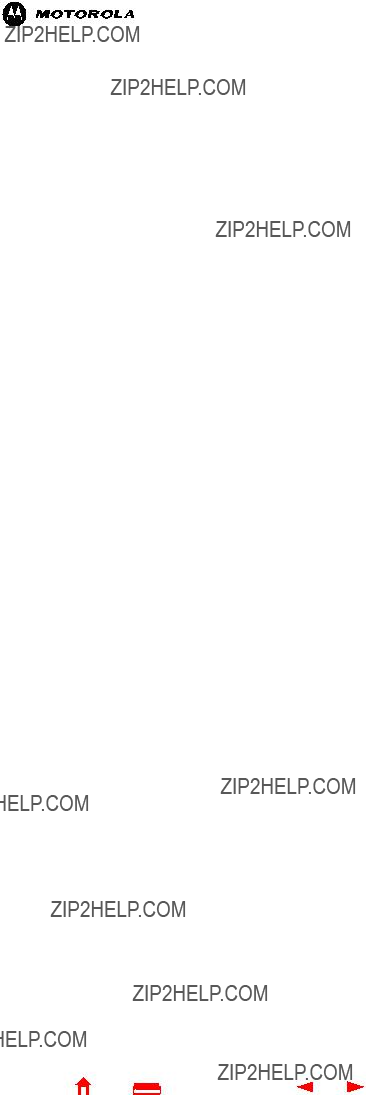
Motorola is not responsible for any third party software provided as a bundled application, or otherwise, with the Software.
U.S. GOVERNMENT RESTRICTED RIGHTS
The Product and documentation is provided with RESTRICTED RIGHTS. The use, duplication or disclosure by the Government is subject to restrictions as set forth in subdivision (c)(1)(ii) of The Rights in Technical Data and Computer Software clause at